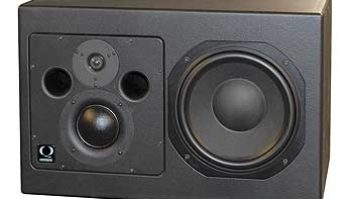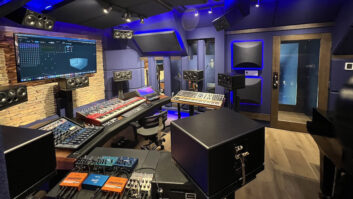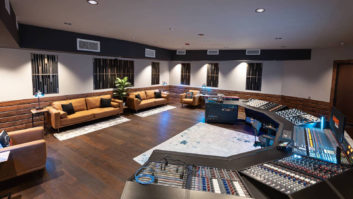ACTIVE POWERED STUDIO MONITORSOver the years, Roger Quested has been a leading designer of high-quality monitoring systems that have been a popular choice with studios, broadcasters, mastering facilities and remote recording vehicles throughout the UK. Quested’s latest model is the VS3208, a three-way, active design with 440 watts of onboard tri-amplification, making it the company’s largest self-powered system. Retail is $3,700 each.
TECHNICAL DETAILSThe VS3208s contain dual-proprietary, 8-inch woofers (each housed in its own internal driver chamber), a 3-inch, soft dome, midrange driver (also enclosed within its own chamber) and a 111/48-inch, soft dome tweeter. The rear-mounted amplifier unit supplies 230 watts to the woofers, 110 watts to the mid-driver and 100 watts to the tweeter (all ratings RMS continuous). The system’s rated frequency response is 40 to 18k Hz (ñ2 dB). An optional VS1115 subwoofer is available for use in 5.1 surround applications, large rooms or for bass-heavy musical styles.
The front-ported 19x 24.25×16.5-inch (WxHxD) enclosure weighs in at a hefty 104 pounds, and its 19-inch width allows it to be mounted in a standard rack. For installations where soffit mounting is desired, an optional remote mounting kit allows the amplifier section to be located separately from the monitor to ensure adequate cooling. In free-field use, I found that cooling was never an issue. The long heat sinks that run the length of the amplifier unit are highly effective in dissipating heat. Even after long periods of use, the amps were only warm to the touch and never became hot.
Hookup is simple. In addition to an AC power switch and removable IEC power connector, the rear panel features a balanced XLR input connection (Pin #2 hot). If desired, the speakers can also be driven by an unbalanced source. Input level matching controls are also provided, and three-position switches (cut/flat/lift) allow the user to tweak the system’s response to match room requirements or a listener’s taste. The HF switches adds ñ2dB boost/cut above 5 kHz, and the MF switch engages at either 500 or 3k Hz. The LF switch engages either an 80Hz boost or a 100Hz cut. The 100Hz cut position is intended as a highpass filter when the VS3208 is used with an external subwoofer.
The sensitivity control is a recessed, 10-position rotary switch calibrated in 2dB steps from +4 dBu to -14 dBu, allowing users to interface the VS3208s with any system. Lately, I’ve seen too many monitors with continuous sensitivity controls that make precise left/right matching difficult, so the VS3208s’ stepped attenuator is an appreciated touch.
An LED centered in the front logo is a multifunction device, glowing green when the system is powered up, flashing red when the input reaches -0.5 dB of clipping and turning solid red when the VS3208s’ thermal protection switches the amplifier to standby. The VS3208s are capable of maximum SPLs of 112 dB – more than adequate levels for all but the largest rooms, and it’s unlikely that users would see any red LED action under sane listening conditions.
THE SOUNDHaving heard both small and large monitors from this company for years, I am well acquainted with “the Quested sound,” and there’s little wonder that Quested has been a popular choice among classical engineers. However, with the VS3208s, Quested has managed to create a monitor that not only offers sonic finesse and purity, but is more than capable of keeping up with the demands of hard-driving rock.
After experimenting with the contour controls, I ended up keeping everything in the “flat” settings except the HF boost, which rather than a huge bump, is actually an extremely gentle shelving slope and provided a slight high-end sheen that I found natural and never overbearing or shrill.
Placement of the VS3208s is not overly critical, as long as the tweeters are kept at ear level and the distance between the monitors is roughly equivalent to the distance to the listener. The speakers offer a wide sweet spot, with gradual roll-off at extreme listening angles. You don’t get a feeling that the sound disappears or changes in character when you need to reach to EQ a kick drum. However, the VS3208s are designed as mid-field speakers, and the listener really needs to be at least six to eight feet back from the speakers for coherent imaging. The monitors sound best on stands behind the console or would do nicely in soffits in a smaller room or recording truck. Quested offers 37-inch-tall stands as a $290 option.
As would be expected from all-cone-based monitors, the VS3208s’ response is extremely smooth. The 3-inch, soft dome mid does a wonderful job of providing flat, uncolored response in the critical vocal band, but is also able to keep up with the dual woofers. The bass was full and nicely balanced, yet capable of reproducing well below 40 Hz. The tweeter needed a bit of help maintaining balance with the mids – particularly at high levels, and this is where the +2dB boost setting on the HF contour control came in handy, putting the highs into proper perspective.
Without a doubt, the VS3208s’ strongest attribute is their ability to reflect their input precisely. This is not a monitor that’s designed to sound “nice.” Far from one of those “Emperor’s New Clothes” speakers, the VS3208s tell it like it is: Great mixes sound great on these, while less-than-great mixes are reproduced with all their flaws intact. While this isn’t always what the artist or novice producer/engineer wants to hear, such ruthless accuracy is exactly what pro users need from a monitor, and the Quested VS3208s deliver just that.
Dist. by Q.USA, Inc., 5816 Highway K, Wannakee, WI 53597; 608/850-3600; fax 608/850-3602; www.quested.com.




